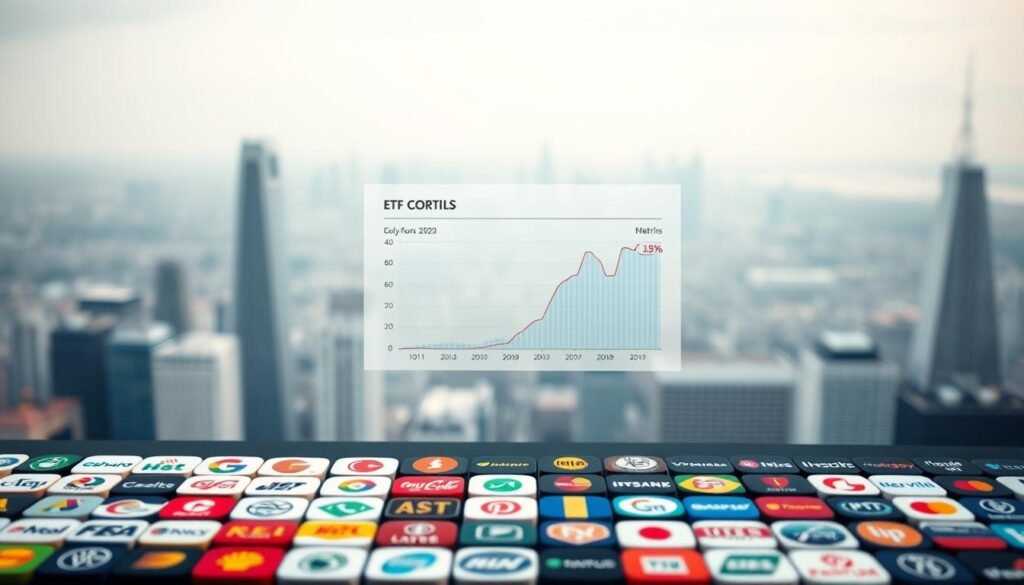
Guide to Best ETFs USA Low Risk Long Term

Imagine you walk into a small town bank to open your first investing account, clutching a notebook of questions.
You ask a teller, "How do I get broad exposure without picking single stock winners?" She points to a shelf of pamphlets and says, "Start with a fund that holds many shares."
This short scene shows the simple appeal of etfs: one purchase can hold many holdings and ease the chore of portfolio building.
In this guide you will find best ways to use etfs and the core building blocks that shape a durable portfolio. We explain how diversified funds help investors balance growth and stability.
You’ll also get a practical list of categories and clear steps to open an account, place an order, and compare price and fees. By the end, you’ll have a friendly checklist to move from research to action.
- Why low-risk ETFs can power your long-term investing in the U.S. market
- The product roundup: low-risk ETF categories built for the long haul
- How to find the best ETFs USA low risk long term for your portfolio
- How to buy ETFs: from opening an account to placing your order
- Diving deeper: the low-volatility factor as a low-risk equity strategy
- Fees, taxes, and risk controls that impact long-term returns
- Your next steps to build a diversified, low-risk ETF portfolio for the present and beyond
Why low-risk ETFs can power your long-term investing in the U.S. market
When you aim for steady growth, choosing broad funds that spread exposure can cut the chance a single slump derails your plan.
ETFs hold many holdings across sectors, so weak spots are often offset by stronger ones. That built-in diversification helps protect value when the market wobbles.
Over time, stocks and equity exposure drive growth, but they swing more. Adding high-quality bonds to your portfolio reduces volatility and helps smooth returns.

Morningstar recommends a core mix: broad US and foreign stock funds plus high-quality bond funds. This approach lowers the chance all assets fall at once.
- Smooth the ride by spreading holdings across hundreds or thousands of assets.
- Mix equities with bonds to cut portfolio swings while keeping a shot at compounding return.
- Automate contributions inside your brokerage account to stay invested through news cycles.
"Simple, diversified, low-cost building blocks can carry you through full market cycles."
The product roundup: low-risk ETF categories built for the long haul
Start with a map you can follow: sort options by role so each holding has a clear purpose in your portfolio. Below is a concise list of fund categories you can mix and match.

Broad U.S. market index ETFs for core equity exposure
These index funds track wide benchmarks to capture market growth while cutting single-company concentration. Use one as your core stock sleeve.
High-quality bond ETFs to reduce portfolio volatility
Investment-grade bonds and core-plus funds cushion swings. For many investors, intermediate-duration bond funds strike a practical balance.
Short-term and inflation-protected bond ETFs (TIPS)
Short-duration funds and TIPS provide stability and guard purchasing power. TIPS often belong in tax-advantaged accounts.
Minimum volatility equity ETFs
Min-vol options target lower drawdowns and smoother rides when markets wobble.
Target-date and allocation ETFs
These single-ticker choices rebalance automatically as your date nears. Morningstar cites some LifePath series as well-regarded examples.
ESG-tilted core options
If values matter, select ESG sleeves that retain broad holdings and tight tracking so you don't trade diversification for ideology.
- Tip: check holdings, index rules, liquidity, and fund size before you buy.
How to find the best ETFs USA low risk long term for your portfolio
A smart starting point is to screen funds by what they charge and how easily you can trade them. Use your broker’s ETF screener to filter by expense ratio, average volume, and total assets.

Use expense ratio as a first-pass filter
For index trackers, aim near or below the 0.15% average to keep ongoing expenses down. Compare expense numbers side-by-side so you spot outliers quickly.
Check volume and liquidity
Look at average daily volume and the bid-ask spread. Tight spreads and larger fund size usually mean you pay less slippage when you place an order.
Inspect holdings, index rules, and replication
Read the index methodology to learn how securities are selected and weighted. Confirm whether the fund uses full replication or sampling; that affects tracking quality.
Compare performance across time windows
Review 3-, 5-, and 10-year records against appropriate benchmarks. Focus on consistent returns and drawdown patterns rather than a single standout year.
Match asset class and strategy to your goals
Decide how each fund fills a role: US stocks, high-quality bonds, TIPS, or commodities. Balance passive index funds for core exposure with selective active funds for specific coverage.
Tip: Build a shortlist, note why each fund qualifies, and verify ticker, bid-ask, and commission policies before you buy.
How to buy ETFs: from opening an account to placing your order
Getting from research to trade takes three clear steps: choose an account, screen funds, and submit an order. Follow a calm process to reduce mistakes and keep your plan on track.
Open a brokerage or pick a robo-advisor
You can open a self-directed brokerage account online; many brokers have no minimums and $0 commissions for trades.
Or use a robo-advisor that builds and rebalances portfolios of etfs for about 0.25% a year if you want automation and guidance.
Screen funds and verify ticker, price, bid-ask, and fees
Use the broker’s screener to find low-cost options. Double-check the ticker, current price, bid-ask spread, and any account-level fees before you buy.
Pick how you want your order executed: a market order fills fast, while a limit order controls the execution price.
Consider stop or stop-limit options for risk control, but know that gaps and fast markets can affect fills.
- Decide your setup: self-directed account for control or robo-advisor for hands-off investing.
- Verify trade details: ticker, order type, shares, funding source, and pre-trade confirmations.
- Remember: etfs trade intraday like stocks, with real-time quotes and visible order books.
Tip: Keep a short trade note with your rationale and time horizon so you avoid needless changes during routine market noise.
Diving deeper: the low-volatility factor as a low-risk equity strategy
If you prefer fewer sharp drops, the min-vol factor offers a structured way to temper drawdowns. It tilts your equity sleeve toward stocks with lower historical volatility so swings are smaller.
What “min vol” means and why it helps in down markets
The minimum volatility approach selects calmer stocks and applies constraints to sector weightings. That trade-off can reduce drawdowns in weak markets while giving up some upside in rallies.
Costs and coverage: TER ranges, indices tracked, and available funds
Typical total expense ratio sits near 0.25%–0.30%, which is competitive for a targeted fund. Several index families exist MSCI World Minimum Volatility is common and about eight global options track six indices.
Recent performance snapshots of min-vol indexes and funds
MSCI World Minimum Volatility shows modest multi-year gains: 1 month -0.22%, 1 year 1.48%, 3 years 18.41%, and 5 years 45.04% (EUR, dividends included to 28/09/25). That pattern highlights defensive characteristics and improved risk-adjusted returns over cycles.
"Use min-vol as a complement, not a replacement, for core index exposure."
Fees, taxes, and risk controls that impact long-term returns
Hidden trading charges and tax rules quietly change your after-tax growth. Even when brokers advertise $0 commissions, the ongoing expense ratio still reduces what you keep.
Expense ratios and trading commissions: what you actually pay
Expense ratios are an annual drag on returns. A small difference compounds over years.
Check whether your brokerage adds regulatory or ticket fees. These show up at trade time and affect the price you pay.
| Cost type | Where it appears | Typical impact | What to check |
|---|---|---|---|
| Expense ratio | Annual fund fee | Reduces net returns over time | Compare similar funds by TER |
| Trading commissions | Per trade (now often $0) | Can add to entry/exit cost | Confirm broker policy and hidden fees |
| Bid-ask spread | At order execution | Causes slippage on thin assets | Check average volume and spread |
Tax location considerations for bonds, TIPS, and equity funds
Place tax-inefficient assets where taxes bite less. TIPS often generate taxable inflation adjustments, so keep them in tax-sheltered accounts when possible.
For taxable accounts, municipal bond funds can be attractive if they match your situation. Otherwise, prioritize high-quality taxable bonds in retirement accounts.
Tip: Document which asset goes in which account and review it annually to avoid surprises around year-end distributions.
- Keep an eye on expense and fees; they compound and affect your final returns.
- Revisit risk controls every year: position size, rebalancing bands, and cash buffers help manage volatility.
- For allocation or target-date funds, note how they shift toward bonds as your target date nears to reduce sequence risk.
Want budgeting help while you plan asset location? Check this free budgeting tools resource to keep contributions and tax planning aligned with your portfolio.
Your next steps to build a diversified, low-risk ETF portfolio for the present and beyond
Start by choosing one core stock index fund and a quality bond fund to form a simple, balanced base. Add a low-volatility sleeve or TIPS for inflation defense if you want smoother returns.
Use your broker’s screener to build a short list of etfs by cost, asset mix, and holdings quality. Spot-check top companies, sector weights, and the fund’s rating before you buy.
Consider a target-date option if you prefer a single-ticket path that shifts toward more bonds as your date nears. Be wary of hot themes like gold miners or crypto; they can swing widely and may not match your investment goals.
Finally, map assets across accounts for taxes, schedule annual rebalances, and verify ticker, spreads, and order type before you execute.
If you want to know other articles similar to Guide to Best ETFs USA Low Risk Long Term you can visit the category Scholarships.






Leave a Reply